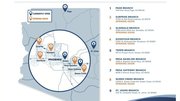News
Japanese currency redesign to boost ATM business
August 5, 2002
TOKYO -- Japanese ATM manufacturers are expected to experience a boost in business when the Japanese government and Central Bank issue new high denomination currency notes in 2004 in a bid to stamp out counterfeiting and energize the economy, according to reports in the Asahi Shimbun and the Daily Yomiuri.
Finance Minister Masajuro Shiokawa said the government will issue a new series of 1,000, 5,000 and 10,000 yen Bank of Japan notes (worth roughly $8.40, $42 and $84 U.S.).
The redesigned bills, updated for the first time in 20 years, would be more difficult to forge, he said during a news conference. Shiokawa also said the new bills would "brighten up people's sentiment." Trade Minister Takeo Hiranuma said the plan would "affect the social mood... because it serves as an incentive for ink and printing industries."
Vending machines and ATMs will have to be adapted to accept the new notes, which will include holographs and other new features designed to thwart counterfeiters.
The revamped currency could boost gross domestic product by more than 0.4 percentage points, said Shinko Research Co. Ltd. economist Nobuhiko Kuramochi. Benefits would be "some two trillion yen in a very rough estimate mainly thanks to demand for ATMs and vending machines," he said.
But, he warned, "This is different from the fundamental policy of boosting growth potential through structural reforms. I think it was thought out as a desperate measure."
Dai-Ichi Life Research Institute Inc. estimates that about 960 billion yen will be spent in the coming two years on upgrades of ATMs and other equipment, pushing up the gross domestic product by about 0.1 percent.
Dai-Ichi's projections include 317.3 billion yen in printing and related costs, assuming that each bill would cost 17 yen to print. Modifications to ATMs will add 330.7 billion yen and upgrading vending machines will add another 312.1 billion yen to the economy.
One estimate puts the cost of modifying an ATM at 300,000 yen, including software changes and the replacement of sensors that check for note authenticity. With about 152,000 ATMs installed in financial institutions, post offices and convenience stores nationwide, the final bill likely will run to more than 45 billion yen. Each of the major commercial banks probably will have to pay about 5 billion yen to complete the necessary modifications.
"When 2,000 yen bills were brought out in fiscal 2000, our sales increased by 5 billion yen to 6 billion yen. This time, though, there's really no comparison. It'll be huge," an official of Omron Corp. said. The company has more than 20 percent of the market share in ATMs and about 40 percent in the ticket machine market.
Oki Electric, an electronics maker that also makes ATMs, soared 16.74 percent to 279 yen as the most active issue by volume on the first section of the Tokyo Stock Exchange on Aug. 5 after climbing 13 percent on Aug. 2














